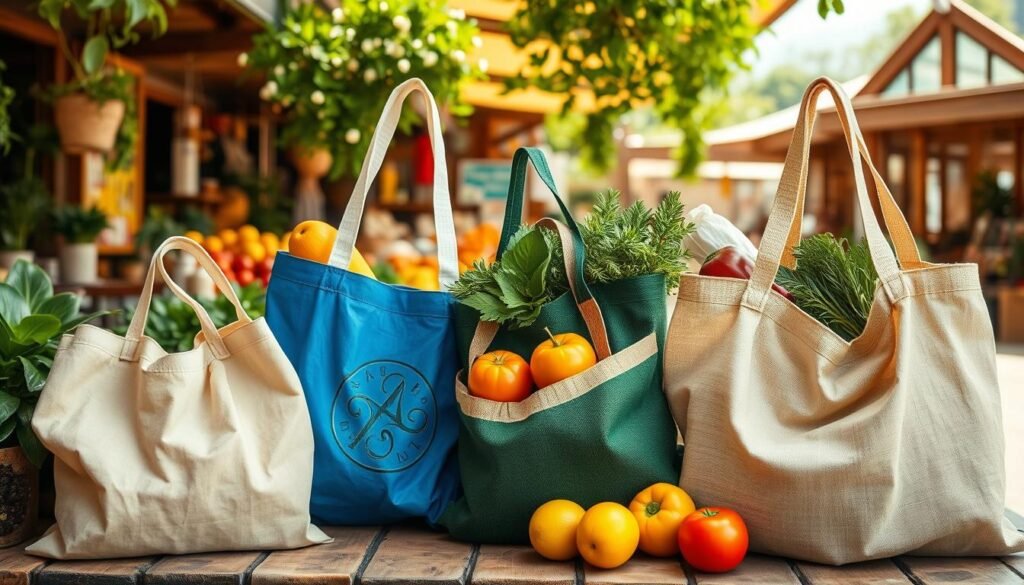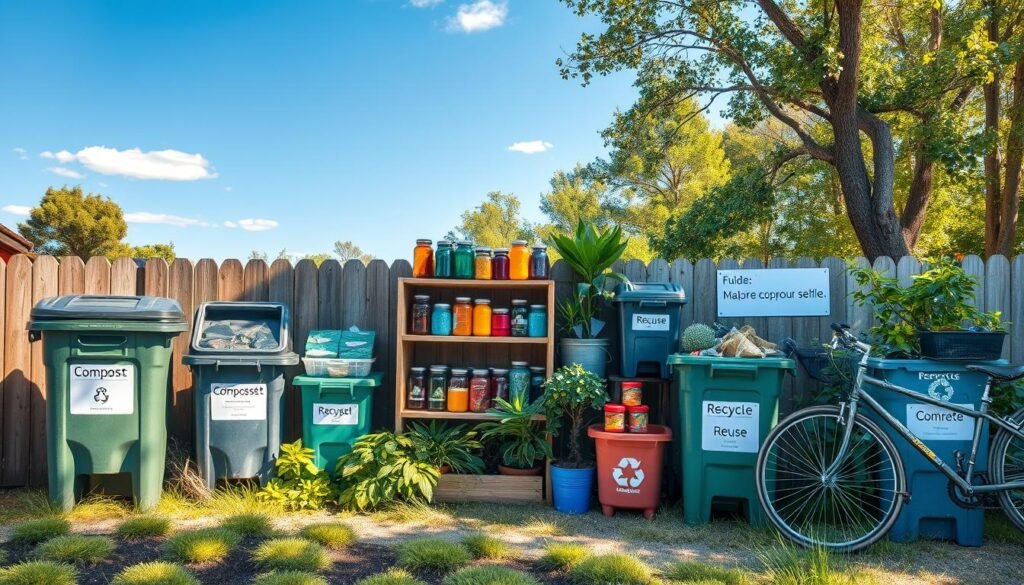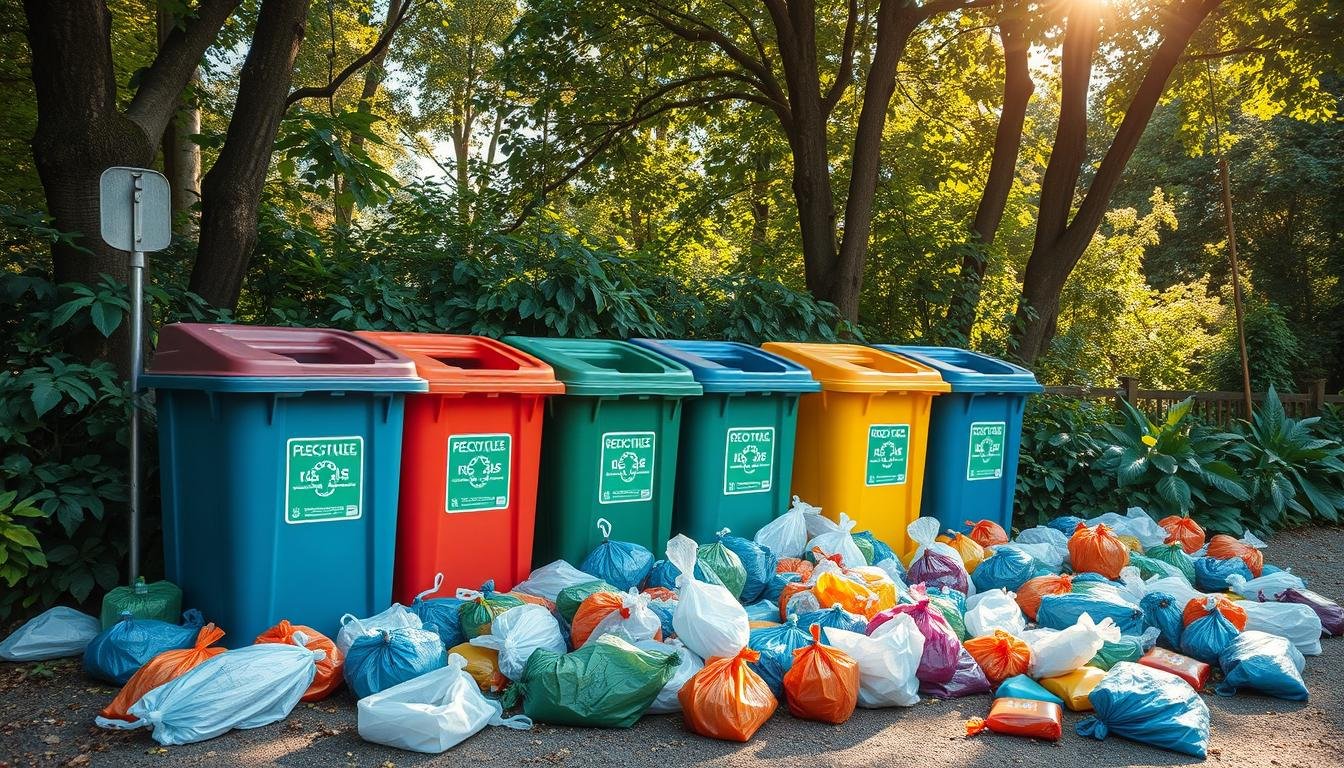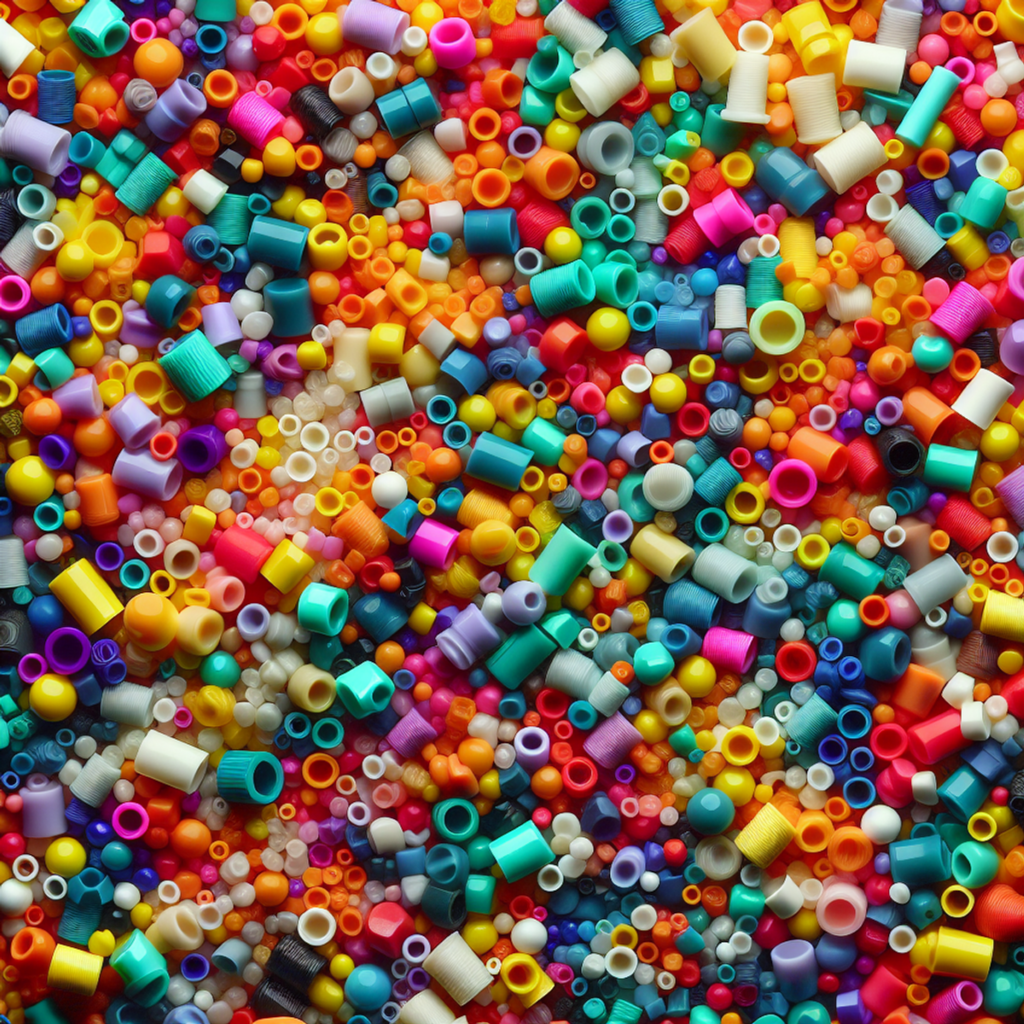19.2% of all municipal solid waste comes from plastics, the EPA shows. This highlights the urgent need to recycle plastic bags. However, few of these bags end up in the recycle bin. We must find sustainable options for plastic bag disposal.
Plastic waste greatly harms our planet, especially marine life. This article points to easy solutions for recycling plastic bags. It helps you take a step towards a greener future. Learn how your everyday shopping bags can help the planet. Finding the right way to dispose of plastic bags is easier than you might think.
Key Takeaways
- Discover convenient locations to recycle plastic bags and reduce landfill impact.
- Learn about the importance of plastic film recycling and how to properly prepare bags for this process.
- Understand the limitations of curbside programs and alternative store drop-off options.
- Recognize the role of local mandates in encouraging plastic bag recycling.
- Explore how businesses can partner with organizations like Rubicon for specialized recycling plans.
- Grasp the global scope of plastic bag usage and the critical need to increase recycling efforts.
Understanding Plastic Bags and Recycling
Plastic bags journey from stores to recycling centers involves many steps. It relies on properly handling materials like high-density and low-density polyethylene. These materials are crucial for recycling plastic bags. Recycling them well reduces environmental harm and supports sustainable methods.
The Composition of Plastic Bags
Plastic bags come mainly from three types of polyethylene. These are high-density (HDPE), low-density (LDPE), and linear low-density (LLDPE) polyethylene. HDPE, or #2 plastic, is tougher. Whereas LDPE, or #4, makes bags flexible and stretchy. Knowing about these materials helps in sorting them for recycling.
Preparation Steps for Recycling Plastic Bags
Recycling starts at home. People should first gather bags marked with #2 or #4. These symbols show the bag is recyclable. Next, remove any dirt, like food, receipts, or stickers. These can block the recycling process.
Gathering these bags in one place helps. It’s best to fill one trash bag with 50 to 100 plastic bags. Then, take them to a recycling spot.
| Statistic | Detail |
|---|---|
| Global Annual Usage | 5 trillion plastic bags |
| US Annual Consumption | 100 billion plastic bags |
| Average Usage Time Per Bag | 12 minutes |
| Recycling Rate in the US | Less than 10% |
| Oil Saved Per Ton of Recycled Plastic Bags | Equivalent to nine barrels of oil |
Understanding materials and how to prepare for recycling is crucial. Proper plastic bag recycling saves natural resources. Each recycled bag helps reduce the problems of plastic waste.
The Environmental Impact of Plastic Bags
Plastic bags are everywhere and cause harm to our environment. They are especially bad for the sea and don’t rot away in dumps fast. It’s important we know how they hurt our planet so we can use less of them.
Consequences for Marine Life
Every year, lots of plastic bags end up in the ocean, hurting sea animals. About 34% of sea turtles that die have eaten plastic. They think it’s food. This mistake can block their insides, starve them, and kill them. It shows how bad plastic bags are for nature.
The Longevity of Plastic Waste in Landfills
Plastic bags take 1,000 years to break down in dumps. As they slowly fall apart, they turn into tiny bits called microplastics. These bits pollute the earth and water, harming animals and plants. It shows we need better solutions, like biodegradable plastic and more recycling.
Recycling plastic bags help our planet by reducing trash and saving resources. Recycling one ton of bags can save 11 barrels of oil. To know more about recycling, check out this guide on plastic types.
Using biodegradable bags and recycling more can lessen plastic’s bad effects. If everyone does their part, we can fight plastic pollution. This will make our world cleaner and safer for the future.
Breaking Down the Recycling Process for Plastic Bags
The journey of recycling plastic bags is both complex and essential for the environment. It shows us the value in turning everyday items from waste into resources. Understanding the plastic bag recycling process helps us see the hard work involved.
From Bags to Plastic Pellets
First, we collect and sort plastics, focusing on types HDPE #2 and LDPE #4. These plastics are cleaned to get rid of contaminants. Then, the clean material is shredded and melted into recycled pellets.
These pellets are key in recycling, as they can be turned into many new products.
The Journey Beyond: Repurposing the Materials
Once turned into pellets, plastic bags start a new life. These pellets help make not just new plastic bags but also many other products. For instance, they’re used in making plastic lumber, a sustainable choice for outdoor decks and furniture.
Companies like Trex use these pellets for high-quality plastic lumber. This shows how effective recycling can lead to a circular economy.
By understanding the full plastic bag recycling process, we see how vital recycling is. It reduces plastic waste and supports sustainability. Recycled pellets make products like plastic lumber possible, battling the issue of plastic pollution.
Where Can I Recycle Plastic Bags Across the Country
Finding where to recycle plastic bags in the U.S. is vital for those of us who care about the environment. Not every curbside program will take them because they jam up the recycling machines. Luckily, you can drop off used plastic bags at recycling plastic bags USA points in many stores.
Stores like Kroger, Safeway, Target, and Walmart are part of these recycling efforts. They help gather the bags, which are then squashed, tied up, and sent off to be made into new items. This way, we reduce waste and avoid making more plastics.
Remember, only specific plastic bags can be recycled this way. Accepted types include grocery and produce bags, bread bags, cereal liners, water bottle wraps, dry cleaning bags, and Amazon package film. Look for the How2Recycle label to make sure your plastic is type #2 (HDPE) or #4 (LDPE) and can be recycled at stores.
A new Store Drop-off directory is coming to help you find recycle spots easily. It’s going to make sure plastics get to the right place, keeping them out of other recycling or causing equipment problems.
- Look for recycling bins in stores, guided by local listings and store signs.
- Before recycling, take off any stickers or residue from the bags.
- Tell people you know about recycling plastic films correctly.
By recycling this way, we support a cycle where plastics get a new life. They can become decking, synthetic lumber, or even new plastic bags. This aids our push for a greener world.
Store Drop-off Recycling: A Convenient Option
Store drop-off recycling makes it easier to recycle plastic bags, wraps, and films. Items with the How2Recycle label are accepted at many stores across the country. This boosts recycling efforts and helps the environment.
How to Locate Participating Retailers
It’s easy to find stores that offer drop-off recycling. Look at national and local groceries that are joining the movement. You can spot participating spots by the How2Recycle label on bins inside or near the store. For more help, retail sites and How2Recycle.info list places where you can recycle.
Eligible Plastic Bag Types for Store Drop-off
Grocery and produce bags, dry cleaning bags, and plastic films are all recyclable. Before recycling, make sure the plastics are clean and dry. They should also be free of food or other waste. This way, only good-quality materials are recycled.
By using store drop-off recycling, people help cut down on plastic pollution. These programs are growing, making recycling easier. This leads to higher recycling rates and less harm to the environment from plastics.
Paper vs. Plastic: Which Is More Eco-Friendly?
Choosing eco-friendly bags is a big topic. People often debate over paper or plastic bags. Both types affect the environment in big ways. They are different in how they’re made, used, and recycled. Also, reusable bags could be the best choice for the planet.
Comparing Production and Disposal Impacts
Making paper bags needs a lot of water and energy. They need three times more water than plastic ones. They also create 70% more air pollution. Even though paper bags break down naturally and are recycled more (about 66%), they still pollute a lot. They increase water pollution and garbage issues.
Plastic bags come with their own problems. Americans use about 100 billion plastic bags a year, but recycle less than 5% of them. They can linger in landfills for up to 1,000 years, harming animals and nature. They are lighter and need less energy to make and move around, though.
Opting for Reusable Bags as the Best Alternative
Reusable bags, like cotton or nonwoven polypropylene (PP), are great despite their manufacturing impact. A cotton bag needs to be used 131 times, and a PP one 11 times, to be better for the planet than single-use plastic bags. They are strong and can be used many times. This makes them the greenest option over time.
Choosing reusable bags cuts down the need for throwaway bags. This helps fight pollution and save the environment.
The data here shows how paper and plastic bags stack up environmentally:
| Product | Fossil Fuel Use (kg) | Municipal Solid Waste (kg) | CO2 Emissions (tons) | Water Use (gallons) |
|---|---|---|---|---|
| Plastic Bags | 14.9 | 7 | 0.04 | 58 |
| Paper Bags | 23.2 | 33.9 | 0.08 | 1004 |
Paper bags seem greener because they break down and are recycled more. But, they have a bigger environmental footprint than plastic bags during their lifecycle. However, reusable bags are the top eco-friendly choice. They make a big difference by using less material and creating less waste.

Local and State Plastic Bag Recycle Mandates
In the US, work to manage waste better highlights rules on plastic bags. This includes laws on bag use, recycling rules, and local recycling laws. Some places have fully banned them, while others focus on recycling.
The Role of Community Laws
Local recycling laws are key in managing plastic waste. For example, California and New York have strict bans on disposable bags. This pushes for more recycling and the use of reusable bags. Communities themselves decide on plastic recycling rules, showing they care about the environment.
How Legislation Encourages Plastic Bag Recycling
Recycling rules often come with educational efforts to raise awareness. In some states, stores must charge for certain bags. This money goes into teaching people about the benefits of recycling. It makes recycling more appealing and helps the environment.
Laws in many states aim to reduce plastic waste. In California, for instance, stores can’t give out single-use plastic bags. They must offer reusable or recyclable options. This reduces pollution by ensuring plastics meet recycling standards.
Places like Alaska and Illinois have their own rules, with some towns banning or charging for plastic use. These actions promote recycling at the community level. It shows that efforts in different places can have a big environmental impact.
To conclude, both state and local rules are leading to less plastic use in the US. As more places adopt these laws, our fight against plastic waste gets stronger. We’re moving towards better care for our planet.
Recycling Myths: Clearing Up Confusion Around Plastic Bags
There are many recycling myths out there, especially about plastic bags. These myths confuse people and mess up recycling processes.
The Curbside Recycling Misconception
A big myth is that all plastics with the recycle symbol can go in curbside recycling. This isn’t true for plastic bags. They often get stuck in sorting machines, causing problems.
These bags can be recycled, but they need special handling. Curbside programs can’t do this.
Learn about technologies for recycling complex plastics. Check out this guide on plastic recycling machines.
The Truth About Recycling Bin Colors
Many people are confused by the colors of recycling bins. They think the color tells you what goes inside. But, the meanings of the colors change depending on where you are.
It’s important to know your local recycling rules. This helps make recycling more effective by lowering the wrong items being thrown in.
To wrap up, knowing what can go in recycling bins is key. Also, follow your area’s recycling guidelines. This makes sure recyclables, like plastic bags, get processed right. By busting myths, we boost recycling and help our planet.
| Material Type | Recyclability | Notes |
|---|---|---|
| Plastic #1 (PET) | Highly recyclable | Widely accepted in curbside programs |
| Plastic #7 (OTHER) | Non-recyclable | Includes non-standard plastics like PLA |
| Plastic Bags | Recyclable | Requires specific drop-off locations |
| Metal | Infinitely recyclable | Color of bin does not impact recyclability |
| Glass | Infinitely recyclable | Generally not affected by dye |
By learning and following the right ways to recycle, especially with plastic bags, we help the environment. Let’s work together for better recycling.
Additional Resources for Conscious Consumers
People who care about conscious consumerism can learn a lot from recycling resources and environmental guides. These tools help them make choices that are better for the planet. We have gathered a list of resources to help you live more sustainably.
- EcoEnclose: Offers a variety of shipping boxes that are 100% recyclable and biodegradable, ideal for conscious consumers looking to reduce their carbon footprint in shipping and packaging.
- Packlane: Provides Econoflex shipping boxes made from 100% recycled Kraft material, supporting the push for biodegradable packaging solutions.
- Storopack and Good Natured: These companies offer bioplastics made from Polylactic Acid (PLA), which are biodegradable under the right environmental conditions, offering a more eco-friendly alternative to traditional plastics.
- Green Packaging Group: Features a range of eco-friendly shipping options, including boxes, envelopes, and mailers, aimed at businesses and individuals striving for sustainability.
- Papermart and Amazon: Provide numerous options for recyclable padded mailers, helping reduce waste in everyday shipping needs.
Using recyclable materials and joining recycling programs helps the planet. Recycling things like plastics and aluminum is key. Disposing batteries and big items at Buyback Centers is also important.
Choosing products with less packaging and avoiding one-use items will lead to a greener life. Buying in bulk to reduce packaging and picking biodegradable options can lower your environmental impact.
Knowing how long plastics and glass take to break down shows why recycling is vital. Making wise product choices is a crucial part of being a green consumer. Through recycling resources and smart shopping, you can make a difference in our world.

Conclusion
In our deep dive into plastic bag recycling, we learned a lot about how they fit into our green goals. Right now, only about 12% of plastic bags are recycled in the U.S., which shows we need to do more. Better recycling could turn trash into valuable items like composite lumber or playground gear.
Our look into recycling shows it’s good for both the planet and our pockets. For example, businesses in Wisconsin save money by recycling plastic films. Yet, recycling is complex. For example, compostable bags can mess up regular recycling unless they’re handled right. They shouldn’t end up creating methane emissions.
The harsh truth? Recycling rates are dropping in the U.S., from 9% in 2018 to 6% in 2021. Challenges like sorting plastics correctly or dealing with tricky packages are real. But stores like Target and Kroger are trying to help by taking back these materials. We need to pay attention to recycling symbols and know which plastics go where.
Looking forward, it’s clear that what we do now will shape our environmental future. As plastic use is expected to rise, it’s crucial to get better at recycling. It’s not just a good idea but necessary for a cleaner planet. Our choices today matter for tomorrow’s earth.
FAQ
What types of plastic bags can I recycle?
Plastic bags made of high-density polyethylene (#2) or low-density polyethylene (#4) are recyclable. These include grocery and produce bags. Just look for the #2 or #4 symbol to make sure.
How should I prepare plastic bags for recycling?
First, take out any receipts or stickers. Keep your bags in one spot. When you get 50 to 100, pack them into a single garbage bag.
Why are plastic bags harmful to marine life?
Birds and fish often eat plastic bags by mistake, which can kill them. The bags stay in the ocean for a long time, hurting marine life and ecosystems.
What happens to plastic bags during the recycling process?
First, the bags are turned into chips. Then, they’re melted into pellets. These pellets can make new items like plastic lumber or even new bags.
Where can I find plastic bag recycling locations?
Look for recycling bins at stores like Kroger, Safeway, Target, and Walmart. It’s best to use these bins instead of curbside recycling for your plastic bags.
How can I find stores that participate in the drop-off recycling program for plastic?
Use online directories like How2Recycle.info or check for the Store Drop-off label on products. This will show you where you can recycle plastic bags.
Are paper bags a more eco-friendly option than plastic bags?
While paper bags are better for the ocean and easier to recycle, they’re not perfect. They use more water and energy to make. The best choice is using reusable bags.
Are there any laws mandating plastic bag recycling?
Some places have laws about plastic bags. These might ban them, make stores recycle them, or add a tax. They try to protect areas with lots of water.
Can all plastic bags be recycled in curbside recycling programs?
Not all bags can go in curbside recycling. Putting them in can mess up recycling plants. Always use store bins or check local rules first.
Does the color of a plastic bag affect its recyclability?
Yes, particularly black bags are hard to recycle because of the dye. It’s important to sort recyclable bags correctly.
Where can I find more information on recycling and sustainable practices?
For more info, check online guides and directories. They offer lots of tips on recycling, reducing your impact, and being a conscious shopper.






